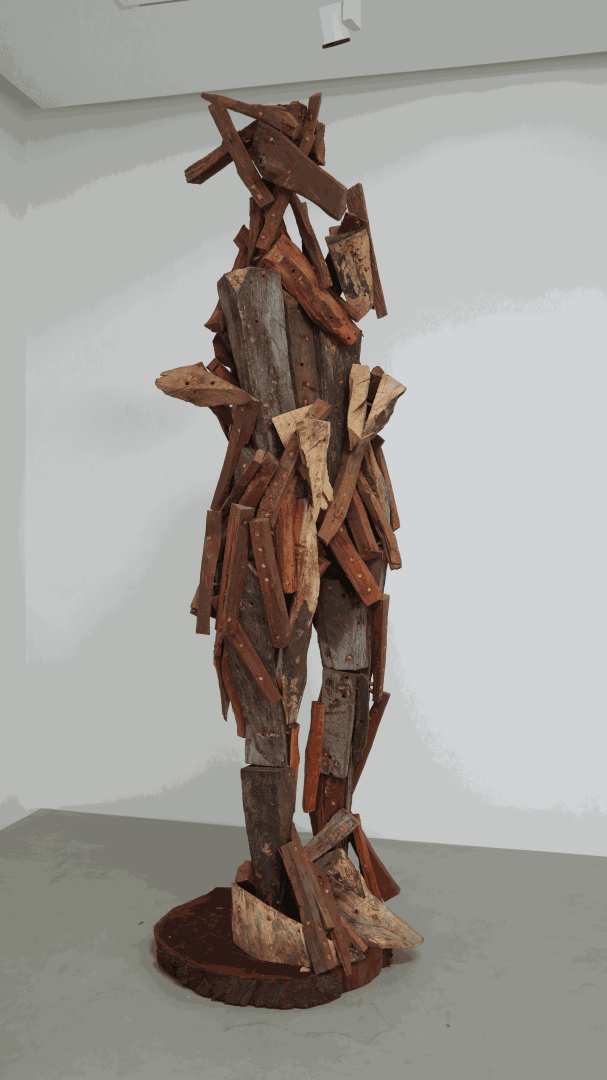Galerie Cécile Fakhoury - Abidjan is pleased to present in its Project Space the work of three artists, Soro Kafana, Serge Nemlin and Le Moane, belonging to the new generation of sculpture in Côte d’Ivoire. With Jems Koko Bi, whose solo exhibition Patrimoine is held in the main gallery, they share a history; that of a decisive encounter at the time of their training in the early 2010s, of a demanding apprenticeship with the one they consider their master, of an emancipation as well and of a search for their singular expression. They also share the story of their encounter with trees, with wood, and the evidence of their communion with this living and plastic material, whose mysteries they each try to reveal in their own way.
Born in 1991 in Mankono in the north of the Ivory Coast, Soro Kafana came to sculpture through ironwork. Coming from a family of craftsmen, with a father who was a blacksmith, he attended workshops since his childhood, where he first observed and then learned the work of iron and wood. Guided by his plastic arts teacher, he then chose to enter the INSAAC in Abidjan, where he explored monumental sculpture in clay with Koffi Donkor. Little by little, wood became his favourite material, with which he discusses and communicates. If his work can sometimes seem like a struggle, a trial, nothing is imposed on wood. Soro Kafana negotiates with the material, consults with it, its forms and the experience it carries within it. By confronting the tree, he confronts himself, the otherness that exists within him and thus questions his identity, between ancestral African traditions and cultures from elsewhere. In the work Moi et le moi, for example, he illustrates this hybrid identity through a kind of dance between two characters, on the borderline between combat and union, between power and harmonic tension. The bas-relief also, entitled Past and Future, bears witness to the complexity of identity and its ever unfinished character, to be affirmed or constructed. In Soro Kafana’s work, the presence of the double is not distressing. Rather, it takes the form of a suggestion to introspection, of a humble recognition of the eternal evolution of things, a humility that the artist learns every day in contact with the trees, the great sages of the forest.
Mominé, whose artist name is Le Moane, was born in 1986 in Man. He learned woodworking from his carpenter father, and has been working with wood ever since as an artist. Woodworking is for him a way to communion with nature, like a cocoon, sheltered from the incessant noise of the outside world. This background noise, made up of lies and false pretenses, is represented by Le Moane’s arithmetic engravings that adorn his sculptures. Nonsensical equations, hollow words that oppose to the power of these monumental sculpted hands, sometimes open, ready to receive or to give, sometimes closed, the fist not raised but pushed into the ground, as a sign of protest. A sign of affirmation too, transcribed in the verticality of the artist’s sculptures. Contemporary totems, each one can see in them its own prohibitions, fears or cults. But these emblems are as much aesthetic as they are symbolic, the quest for the beauty of form being considered here as a powerful vector of meaning. Le Moane’s work is full of symbols to be deciphered, like a cryptic language, an intermediary language specific to the dialogue between the artist and his material.
Born in Tabou in the southwest of the Ivory Coast in 1985, Serge Nemlin describes his encounter with wood as what allowed him to become ‘a free artist’. Free from academic and formal constraints, free to take advantage of the infinite possibilities of wood, in tune with the living nature of this material. After studying at INSAAC and meeting Jems Koko Bi in 2013, it was in 2017 that he began to focus on the practice of assembly, particularly using wood shavings. Piece by piece, Serge Nemlin tries to reach a balance, to guess the intentions of the wood, to sculpt first with the eyes, through the imagination, like a 3D puzzle game. For this exhibition, the artist proposes a monumental sculpture entitled The Sentinel, this time made of bundles of wood, thicker than the shavings. Half-human, half-animal, the sentry observes, watches and stands guard. A reassuring figure, she watches over us and protects us. Isn’t this precisely what trees do, as ancestral sentinels, sources of oxygen and life? Serge Nemlin’s work is inhabited by the question of the link between man and nature, fauna and flora, the survival of one depending on that of the other. His assemblage technique appears to us as a mimetic of this vision of life, made of assembled fragments, which gradually draw a story. That of our individual lives, that of our communities, and finally the story behind this exhibition: together we are stronger.
